Pistachio Macarons
Hello friends! Today we are making Pistachio Macarons! I will show you how to make the pistachio flour for the pistachio macarons, and the delicious Pistachio Cream Cheese Filling.
Make sure to watch the video on this page or on my YouTube channel, showing you how to make these macarons.
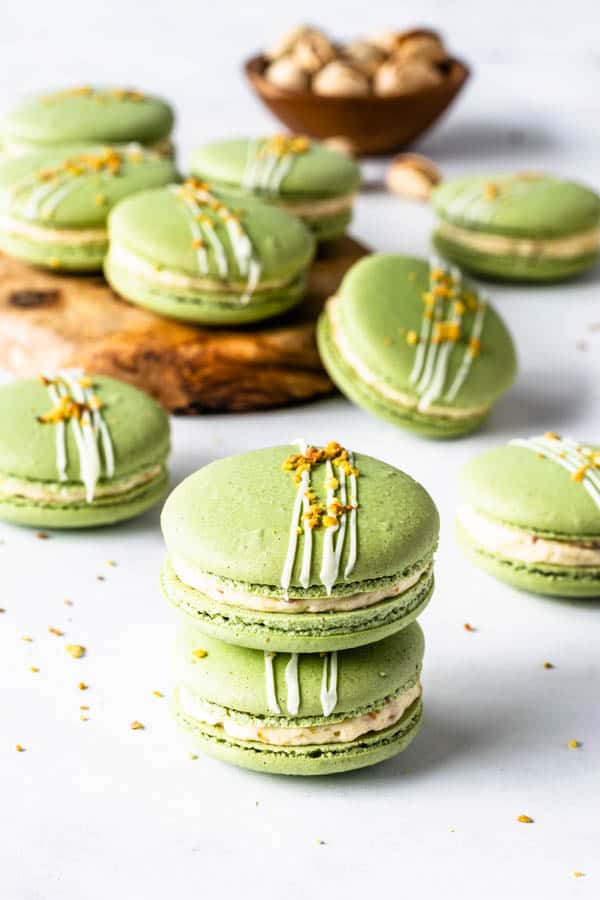
This week I am bringing three French macaron recipes to the blog. The recipe for the Pistachio Macarons is the first one.
This post may contain affiliate links. I earn a commission from qualified purchases. Please read our Privacy policy here.
I had a Macaron Marathon this week. I made 7 flavors of macarons:
- Pistachio
- Coffee
- Blueberry (I have 2 different Blueberry Macaron recipes on the blog: with jam filling, or mascarpone filling)
- Pumpkin
- Lemon
- Raspberry
- Funfetti
A total of 364 macaron shells, and 182 assembled macarons.
Most of these were made for a neighbor.
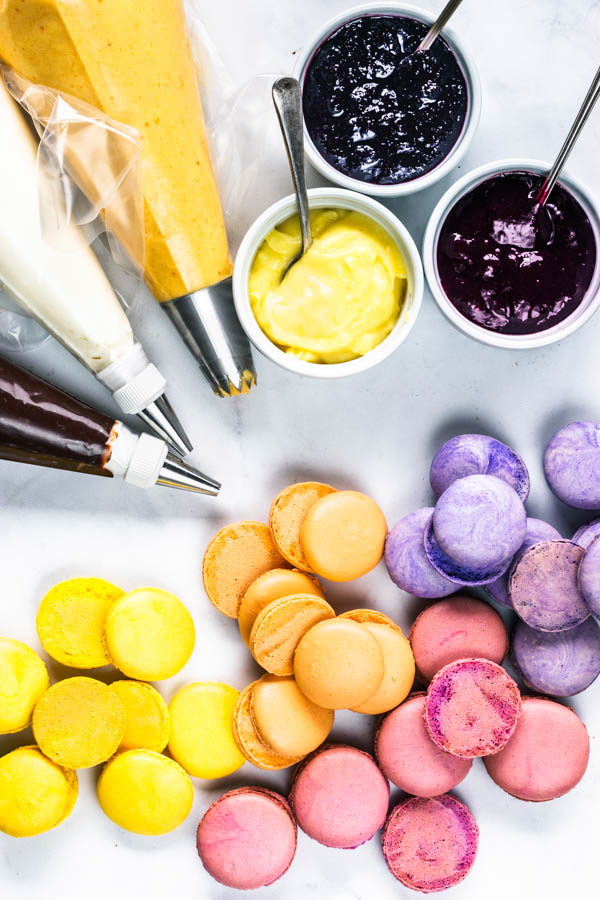
So this week I will bring the recipe for these Pistachio Macarons, then my Coffee Macarons, and finally the Funfetti Macarons.
The Coffee Macarons were used to top my Mocha Cupcakes, as you can see here.
I had the most fun making all of these macarons and can’t wait to show you more pictures in my other posts!
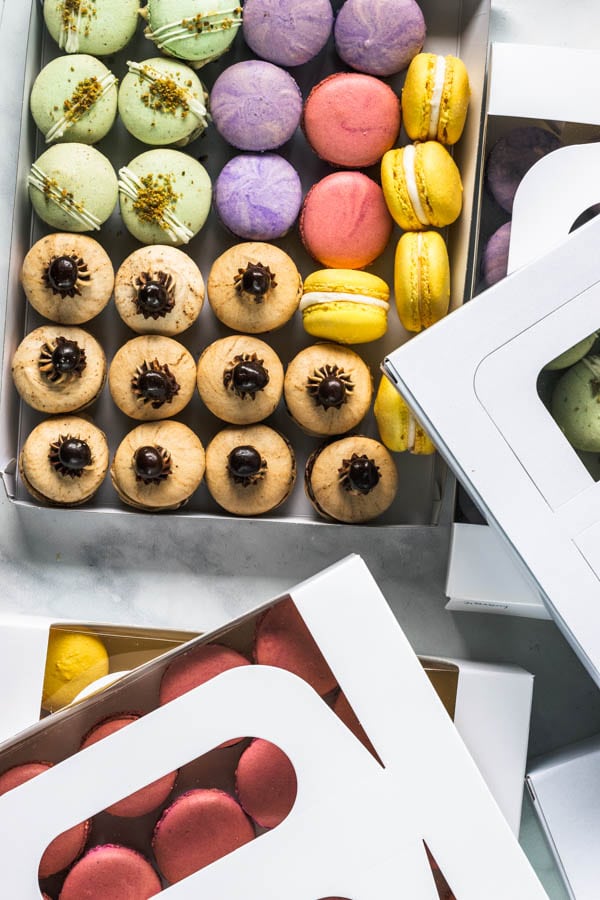
Let’s talk about these Pistachio Macarons.
Ok, so first thing, some people make their pistachio macaron shells with pistachio paste. That’s one route to take. This is a pistachio macaron recipe without pistachio paste. I use pistachio flour instead.
How to make Pistachio Flour
Start with dry roasted pistachios. Very important that they are dry roasted, and not roasted with any oils.
Place one cup of pistachios in a small food processor.
Pulse a few times until the pistachio starts to become ground. Be careful, don’t process to the point that it will start to release oils, and form a paste.
Stop once the mixture is still dry.
It will be very lumpy still, which is ok.
Sift the ground pistachios. And then, place the big pieces that got left out in the food processor, and pulse again to grind them up a bit more. Repeat sifting.
Do this one more time if necessary.
You will obtain a pistachio flour that’s very similar in consistency to the almond flour. I give more instructions bellow with the recipe. Also watch the video to watch me make the flour!

You can use the big pieces that are leftover to make the buttercream for the filling, as you really don’t need the pistachio to be very finely ground for that.
And you can also use the big pieces to to decorate the top of the Pistachio Macarons once you assemble them.
I drizzled some white chocolate over the macarons, and sprinkled some of the pistachio crumbs on top.

For the filling of these Pistachio Macarons, I actually made a Pistachio Cream Cheese Filling.
You’ll see I use a lot of cream cheese frosting in my baked goods, because taste wise is probably one of my favorites, not gonna lie.
And I wish I could eat this Pistachio Cream Cheese Frosting with a spoon. Self-control stops me, thank goodness!
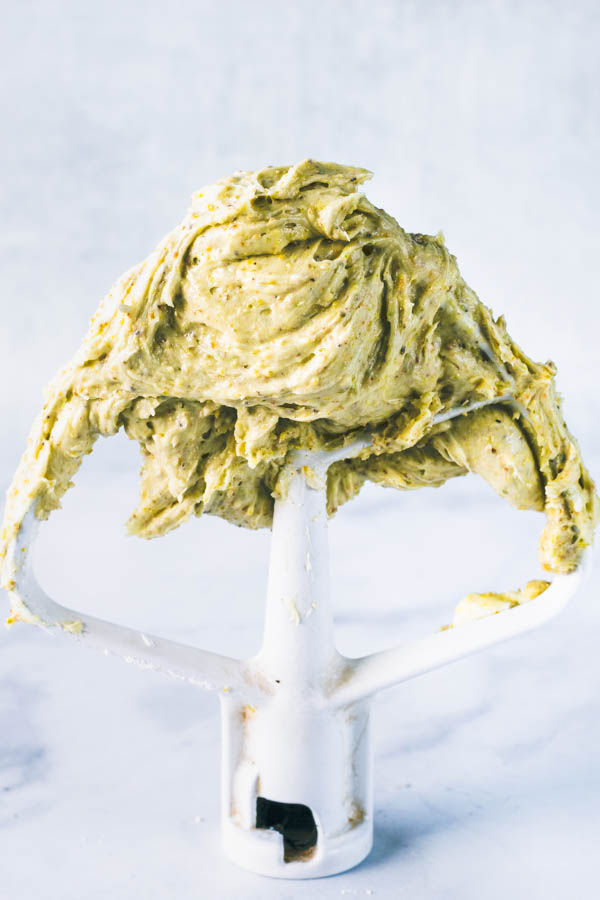
I also want to point out to you the difference on the bottom of my macaron shells. The first picture is from when I first made uploaded this recipe here, 10 months ago. The shells were all uneven, and not smooth. And that is due to using parchment paper to bake my macarons instead of silicon mat.
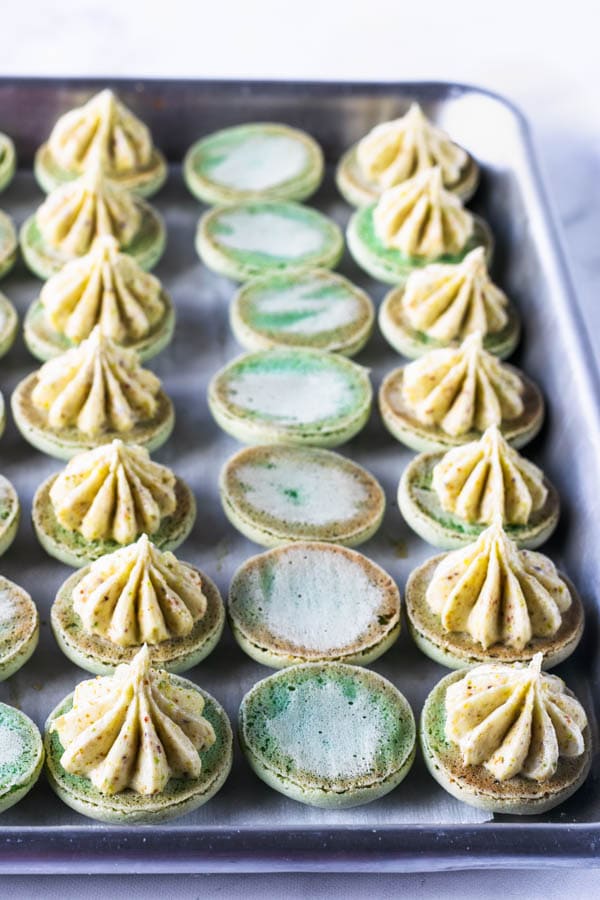
The bottom picture is the most recent one, and look at the improvement on those bottom shells! What do you think? Do you like baking macarons with parchment paper, or do you prefer silicon mat?
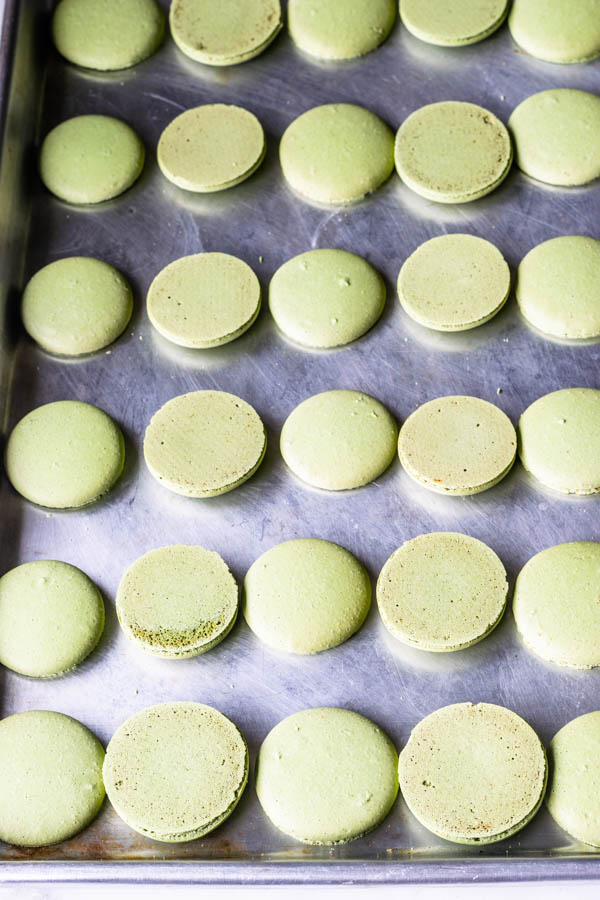
I get asked all the time about tips on how to make macarons. So far, I’ve written several macaron posts and some of them have some important tips that could help you if you want to master how to make French macarons.
I have some video tutorials, and many tips throughout all of my macaron posts that can help you in your macaron baking journey.
Make sure to check out my YouTube channel.
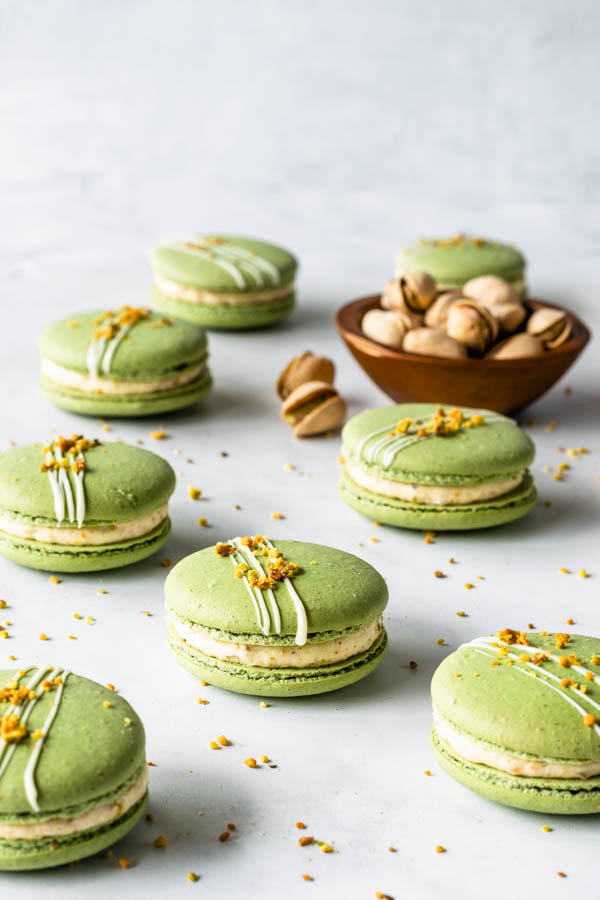
If you want to learn more about making macarons, visit my Macaron School, where I publish everything related to macarons, from troubleshooting guides, to beginner’s guides, and more! Lots of tips, science behind macarons and everything you need to know to help you on your macaron journey.

Here are some more links you might be interested in:
- M&M’s Macarons (with video on how to make different color shells from one batch of macarons)
- Tutorial on the Meringue Stage
- Brownie Macarons
- Balsamic Caramel Strawberry Macarons
- Caramel Popcorn Macarons
- Key Lime Pie Macarons
- Strawberry Lemonade Macarons
To name a few. Go to my Macarons category page to see more macaron recipes and macaron ideas.
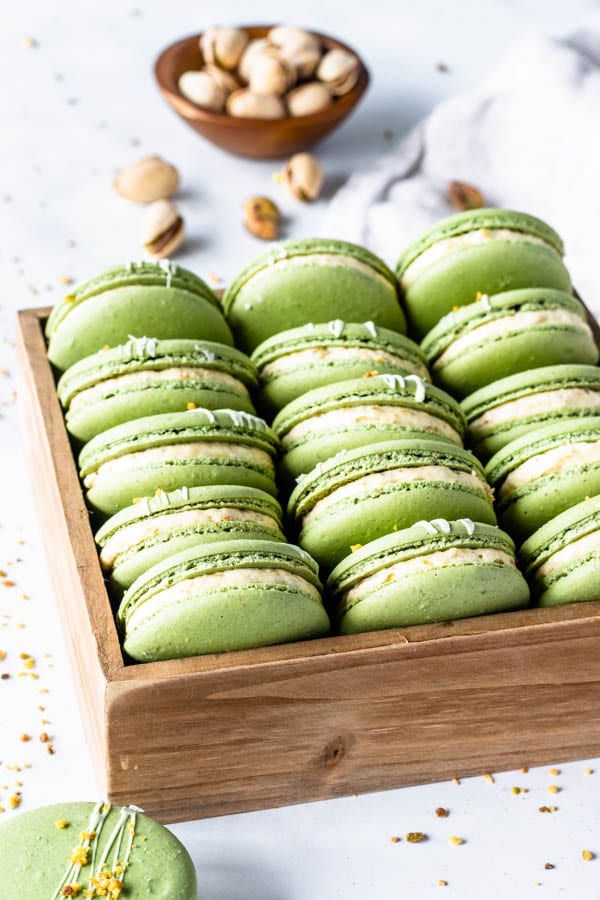
If you have any macaron questions, don’t hesitate to reach out to me over email, or on instagram, over dm, which is probably the best way to reach me.
And if you make any of my macarons, don’t forget to tag me also on social media!
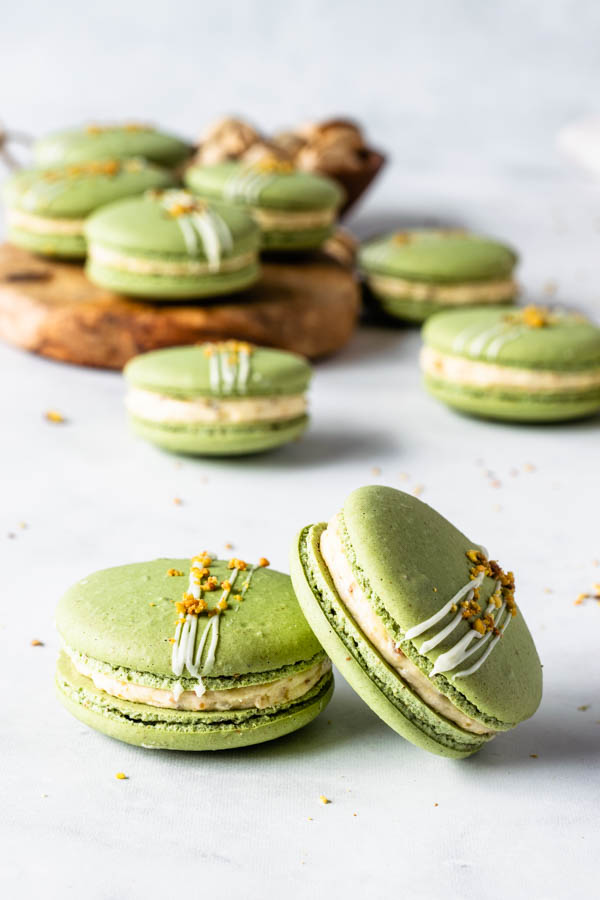
Making macarons can be challenging, but don’t let that stop you. If you really want to master them, all you have to do is to keep on baking. Try to research as much as you can about how to make French macarons, and try to put the tips you learn in practice, and you’ll end up finding what works best for you, your kitchen, and the climate you’re in.
Another thing you need to know about these Pistachio Macarons, is that they are my favorite! They were the first macarons I ever attempted too. Because I just love pistachios so much! What’s your favorite macaron flavor?
I hope you have a great day. Big thanks for reading!!
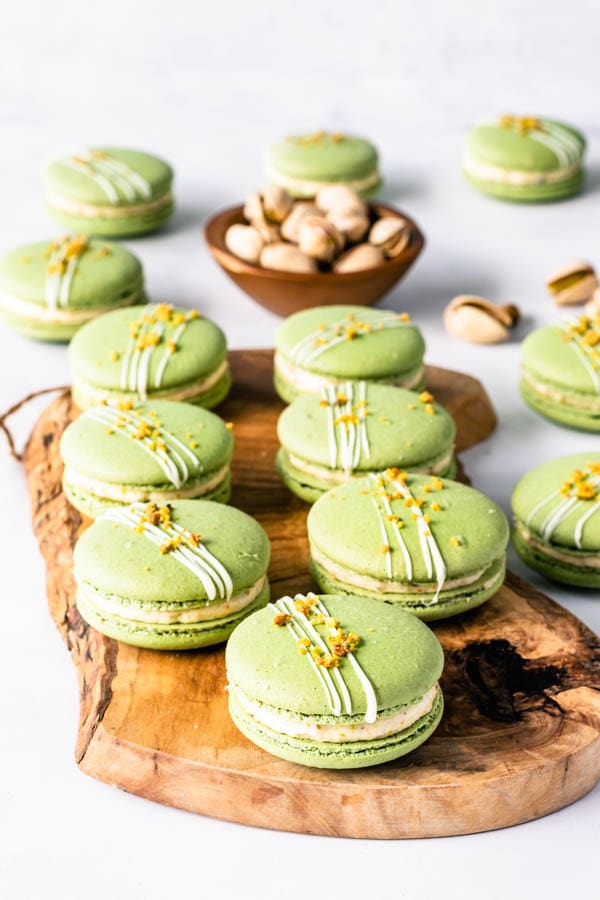

Pistachio Macarons
Ingredients
Pistachio Macaron Shells
- 100 grams egg whites
- 100 grams granulated sugar
- 72 grams almond flour
- 28 grams pistachio flour* see notes
- 90 grams powdered sugar
- A few drops of green food coloring
Pistachio Cream Cheese Filling
- 56 grams cream cheese softened
- 28 grams butter softened
- 125 grams powdered sugar sifted
- 28 grams pistachio flour* see notes
- 1/2 tsp vanilla extract
To assemble
- 28 grams ground pistachio* read notes
- 56 grams white chocolate melted and slightly cooled
Instructions
Pistachio Macaron Shells
- Before you start, get all of the ingredients ready. Prepare a large piping bag, fitted with a large round tip, I use a 1/4” diameter tip. Set aside.
- Line two baking sheets with parchment paper or silicone mat.
- Measure out all of the ingredients.
- Sift the powdered sugar, almond flour, and pistachio flour together. Set it aside.
- Place a bowl over a pan with barely simmering water, making sure the bottom of the bowl isn't touching the water. Add the sugar and egg whites to the bowl.
- Whisk the sugar and the egg whites until frothy and the sugar is completely melted. It will take a couple of minutes. You can test by touching the mixture between your fingers, and if you feel any sugar granules just keep whisking the mixture over the water bath.
- Don’t overheat the sugar syrup, this may cause issues down the line, such as wrinkly macarons.
- Transfer the syrup to the bowl of a stand mixer.
- With the whisk attachment, start whisking mixture on low for about 30 seconds, then gradually start increasing speed to medium. Whisk on medium for one to two minutes, until the mixture is white and starting to become fluffy. Raise the speed to high, or medium-high and whisk for a few minutes until stiff peaks are formed. Best way to check this is to keep your eye on the whites. Once they get glossy and you start seeing streaks formed by the whisk, it might be time to stop.
- Whisk until stiff peaks have formed. When you pull your whip up, the peak should be stiff and shooting straight up, with possibly a slight bend at the top, but not bending down to the side.
- Pour the sifted powdered sugar, almond flour, and pistachio flour into the stiff meringue.
- Add the food coloring at this point, if using. I added a drop of green gel food coloring.
- Start folding gently forming a letter J with a spatula.
- How to know when to stop folding the batter: It’s time to stop folding when the batter is glossy and has a thick and flowing consistency. There are several ways to test this.
- First, pick up some batter with the spatula and try to draw a figure 8 with the batter that is dripping off the spatula. If you can form several 8 figures without the batter breaking up, that’s one indication that it might be ready.
- There’s another test you can do. I call it the Teaspoon test.
- Grab a teaspoon of batter and spoon onto the parchment paper or silicon mat. Wait a minute to see how it behaves.
- If the batter stays stiff, forming a point and doesn’t spread out, fold a little bit more, about 3 folds. Test again.
- Once the batter spreads out a bit and starts to look glossy and smooth on top, on the parchment paper or silicone mat, it’s ready.
- You don’t want your batter to be too runny either. So be careful not to overmix. It’s always best to undermix and test several times until the proper consistency has been achieved.
- When you hold the spatula with batter on top of the bowl and the batter falls off the spatula slowly but effortlessly the batter is ready. The batter will keep flowing off the spatula non-stop, but not too quickly.
- Transfer the batter to the piping bag.
- Place the piping bag directly 90 degrees over the center of each macaron template. Apply gentle pressure and carefully pipe for about 3 seconds, and then quickly pull the bag up twisting slightly.
- Once you’ve piped as many circles as you could, bang the trays against the counter a few times each. This will release air bubbles that are in the batter and prevent your macaron shells from cracking.
- Use a toothpick to pop any air bubbles in the surface of the shells.
- Let the trays sit for a while so the shells will dry out a little bit. I usually leave about 20-40 minutes, depending on how humid the day is. You’ll know they’re ready when you gently touch the surface of a macaron and it seems dry.
- Pre-heat the oven to 300ºF.
- Bake one tray at a time.
- Bake for 5 minutes, rotate tray.
- Bake for 5 more minutes. Rotate again.
- I bake each tray for about 15 to 20 minutes.
- When baked, the macarons will have a deeper color and formed feet. If you try to move a macaron, it shouldn’t feel jiggly. If the macaron is still jiggly, keep baking.
- Remove from the oven and bake the other tray.
- Let the macarons cool down before proceeding with the filling.
Pistachio Cream Cheese Filling
- Beat the butter and cream cheese at medium speed for about 1 minute.
- With the mixer off, add sifted powdered sugar, mix on low to combine. Add pistachio flour and vanilla. Cream for another minute or so until creamy and fluffy.
- Put the filling in a piping bag.
To assemble
- Pipe about 1 teaspoon of filling on top of each bottom shell. Place another shell on top.
- I melted white chocolate and put it in a piping bag, cut a very small hole at the end and drizzled the white chocolate over the macaron shells, and then topped them with ground pistachios.
Storage
- Store macarons in the fridge, in an air tight container for up to 5 days, and in the freezer for about 1 month.


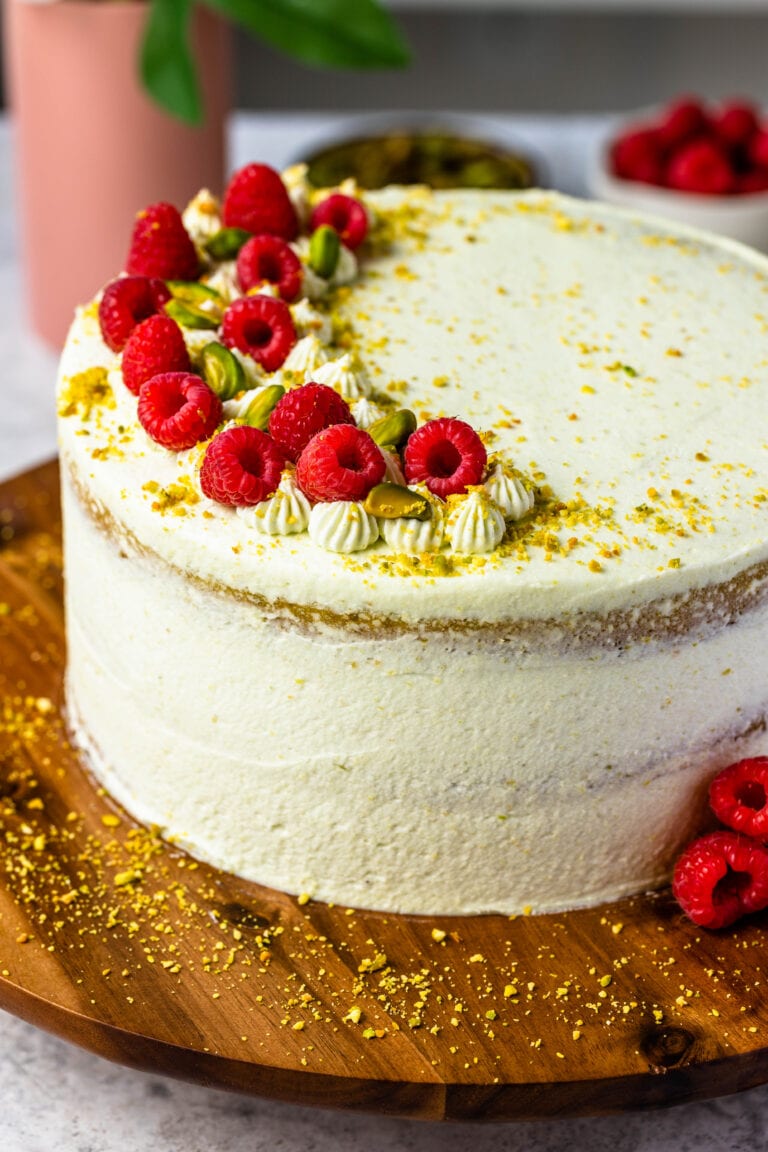


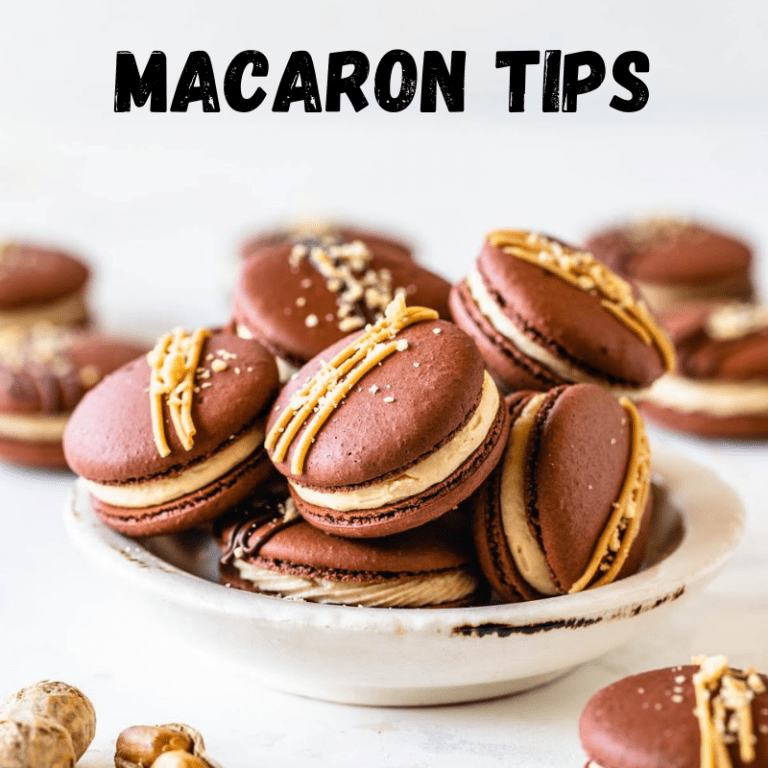
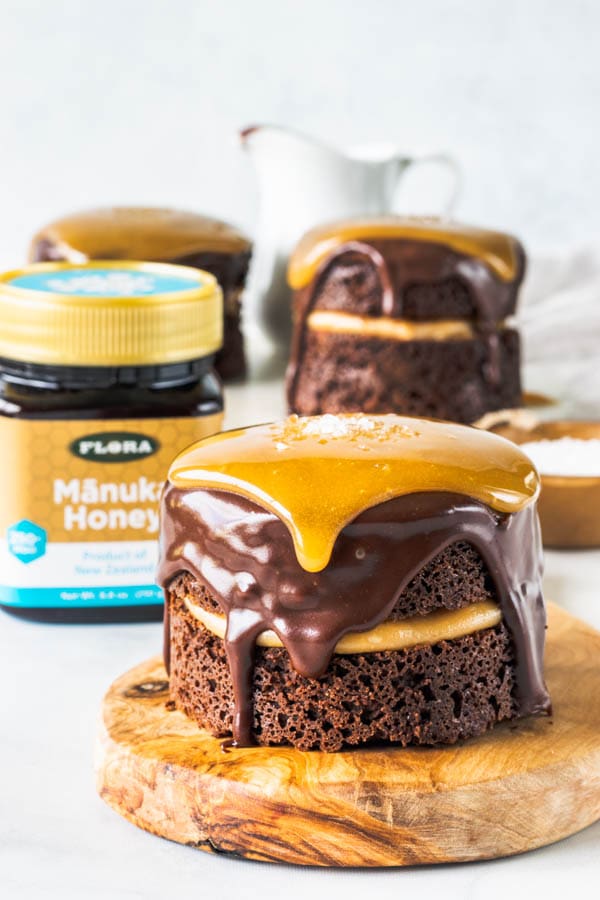

Hi guys, I was wondering if anyone could help me to troubleshoot some of the issues I’ve been having making macaroons.
I tried a non pistachio recipe and it worked perfectly the first time and since then one batch was way too hard, another didnt grow feet, the other one cracked and the top didn’t go hard 🤦🏻♀️
When I made the pistachio batch the mixture spread to much the first time, the second time no feet. So I tried to make some raspberry ones and the mixture grew feet but had a soft top that dropped even after almost 45 minutes baking.
If anyone could give me a hint or tip it would be much appreciated
Ok, my first question is do you have an oven thermometer?
Also, do you have pictures of these batches you can email me or send me on instagram dm, and I can try to help you get to the bottom of the issues.
-About the macarons having feet that spread out too much, it can be from over mixing the batter, or high oven temperature, which is why I am asking if you have an oven thermometer.
-The macarons not developing feet, can be from under whipped meringue, low oven temperature, or the shells didn’t dry enough before baking, your batter could have been too wet, or even over mixed, which makes the batter too “wet” and causes all sorts of issues.
-about the shells growing feel but having a soft top that dropped, it could be also from the batter being too wet and not being dry enough before entering the oven, or the meringue was under whipped, or the batter over mixed.
Seeing pictures of your whipped meringue, piped macarons before baking, and the baked macarons can help pin point what the issue might have been.
Best of luck, and keep practicing because macarons can be like that sometimes, but you got this!
Hi Camila,
Sure I can what’s your email address ?
I tried another batch today same problem the top looks like when you’ve left your tea out for too long and it gets that film ontop 🤮
Literally couldn’t salvage ANY of it!
Oi Camila, What a wonderful recipe! I made it and my macarons turn out amazing! I have pictures but I don’t think I can post them with this comment.
Here are my notes about why your recipe is special:
1 – The pistachio flour in the shell makes a HUGE difference. I’ve made some before without it and they were not the same; not at all.
2 – The cream cheese filling is fabulous as it is not too sweet.
3 – Using the a silicon mat makes is better; the bottoms of the macarons were really smooth.
4 – I got an oven thermometer; and yes, the oven temperature displayed on the panel of my oven was not precise.
5 – Your detailed explanations are ‘very’ important to read for a successful culinary venture 🙂
Pistachio is also my favorite macaron and I am a Brazilian living in the US with a growing passion for making macaron (I always LOVED them). Seu site é maravilhoso e fiquei sua fan! Beijinhos e tudo de bom pra você!
Oi Maria Amelia!! Thank you so much for this wonderful comment and review! Much much appreciated!
Obrigada de coracao!!! beijos e abracos!!! Tudo de bom!
Hello! Your macarons look so perfect 🥺
I have a question: what is your recommendation for celsius degrees in this recipe ? I live in Europe and we only use Celsius. I calculated it on google and it turned to be 162 *C. Isn’t that a little bit too much for the meringue ? I just want to have the perfect temperature 😊
Thank you so much!
Yes that is the temperature I’d use. I often see people recommend 160 celsius in websites using the French or Swiss method. If you choose to use the Italian method, the temperature will probably be lower though. Since I use the Swiss, this is the temperature that works best for me. Make sure you have an oven thermometer. Thank you! 😊
Hii!! I want to attempt this recipe… would be my first time baking macarons. My sisters baby shower is coming up… but she is extremely picky with her macarons. She only likes chewy pistachio with a light filling… nothing too thick like a finished ganache. How chewy is this recipe? What’s your advice on making them chewy and lightly crispy on the outside? Thanks in advance. I am a baker. Just never made macarons before
This is not so much of a recipe matter, but getting the hang of making macarons. Every recipe for macarons is supposed to make chewy macarons on the inside and lightly crispy on the outside. However, there’s a learning curve with mastering this. Some people get it right away, and most take a few months, maybe even years to master them. It may take some time experimenting with recipes and methods to find what works best for you.
But the Swiss method, which is what I use is what has worked best for me and many others. So, if you want to start with this method, I’d recommend watching lots of videos, reading blog posts about it, and reading my tips and detailed information very well. I have videos on youtube that can help you also, and lots of info on my blog posts.
So, to have macarons that are chewy on the inside, lightly crispy on the outside, I’d recommend not over baking them as a start, because that will definitely make them hard.
But many other things can make a macaron hard and crispy, such as over mixing the batter during the macaronage stage, under whipping the meringue, therefore having a “wet” batter, and this will make the macarons crack, or spread out thin, which will make them crispy instead of soft and chewy inside and lightly crispy on the outside.
Also, having hollow macarons will make them crispy, since they will be completely hollow on the inside and just have a crispy shell. And hollow macarons can happen for many reasons such as over whipping the meringue, under mixing the batter, over baking.
The methods are very detailed and specific, so you have to know exactly what each stage is supposed to look like (the meringue, the batter before piping, when it’s baked enough, etc)
I also recommend getting an oven thermometer if you don’t have one, because even the slightest temperature variation can make a huge difference, I am talking just a few degrees can completely make or break.
Basically just read a lot about it and try to practice once or twice before making them for the shower. Plus they can easily be frozen, so you could make them ahead and if they work out, you can freeze them for later and they will stay perfect in the freezer.
If you only have one chance of making them, and no time to practice before the shower, you can send me a dm on instagram as you are making the macarons showing me the meringue, and the batter, etc and I can try to guide you from my end, if I’m available at the time.
This recipe is amazing, I don’t have much experience with macaroons (only made them 2-3 times before) but this recipe was so easy to follow and they turned out perfect! Thank you very much for sharing your tips!
Aweee thank you so much!! I appreciate your feedback!! Have a lovely day!!!
What shade of green is the food coloring that you use? I’m about to try your wonderful recipe but I’m not sure if electric green, forest green, or leaf green, or another is better? The one you use is perfect!
Hello Jess,
I used just a little bit of leaf green 🙂 plus the ground pistachios also help give a bit of color to the batter!
You’re amazing, thank you!!
awe thank you!! 🙂
Hi Camila! I’ve made several of your macaron recipes before (chocolate, lemon, strawberry) and they are always a hit! I tried these and followed the same process as normal but these had cracked tops, which normally doesn’t happen to me. Any ideas? I’m thinking maybe the pistachio flour added too much moisture? Any other tips for fixing cracked top/no feet?
Hey Caroline, cracked top could be a few different things. I help a lot of people with macaron issues, and I myself have had them all in my journey, and I will say that most of the times that the tops are cracked, it’s usually because the meringue wasn’t whipped enough, or the oven temperature was too high. So first, I would make sure that the meringue was whipped to stiff peaks. It happens to the best of us that sometimes we end up whipping slightly more or less for any reason or distraction. Second, I would make sure the oven is at the right temperature. It helps to have thermometers in there, I have a couple in my oven because if one breaks I will know because of the differences in temperature between them, and also to help me see if there are hot spots in my oven, for example, if the front heats more than the back etc… Most home ovens aren’t great at keeping the temperature regular as you set it, so having the thermometers really helps to regulate that.
And finally, let me ask you about the pistachio flour. Did you use dry roasted pistachios to make the flour? Also, did you make sure to process it only until it became fine, and not overprocess it to the point of letting the pistachios release oils?
Anyway, let me know if I can help with anything else! Thank you
Camila
You make it look so easy Camila! Going to try this one…hoping it will turn out as good!!
youre a wonderful baker!! anything you make is fantastic!! thank you so much!!!
Do you have any tips to know when to stop processing the nuts?? I have tried with other nuts (walnuts and pecans) and I feel like they go from big chunks to paste really fast. How fine is acceptable?
It helps if you use dry roasted nuts. Process a few times, and then sift the flour, then process the bigger pieces that got left out again. Just pulse briefly, don’t overprocess them, or they will turn into paste. It has to be fine enough to go through a sifter, which is why it’s good to stop in between, sift what’s already fine, and then proceed to process the pieces that are still too big. That’s my best tip. thank you for your question!!!
Re:pistachio flour- raw or toasted/roasted pistachios?
I’ve only made it with roasted pistachio, but they have to be dry roasted in my experience. I will fix the post in a couple of days and add a video for this recipe, and I will make sure to include that in the recipe. Thank you for your question!
I’ve read in other recipes that when making your own almond flour it keeps it from turning into paste by adding the powdered sugar to the almonds when you process it. Can this be done also to help keep the pistachios from turning into a paste?
Hey Christine, you could definitely do that!! Sounds like a great idea!! I will try that myself too!!!
I love that you use different different piping nozzle to fullness these macs! What # is it if you don’t mind sharing?
Absolutely Sara. The tip I used was the Ateco 829. I just put a link up there at the end of my post to the tip on Amazon. Thank you for asking!! Have a great day!!
i tried to make it and its really deliciouse macarons👍
Thank you so much!!!
I love pistachio macarons! These look so delicious!
Thank you Natalie!!
And when I thought things couldn’t get any better, I saw the words “drizzled with white chocolate” 🙂
This post is a macaron heaven!
Thank you Makos!!! I appreciate it!
This was my first macarons attempt and they came out great! Thank you
That’s so nice to hear!! Thank you Jana!!!